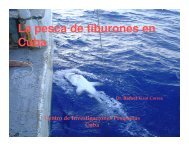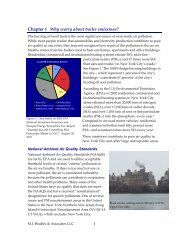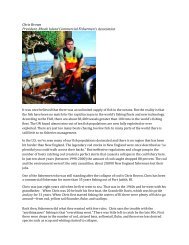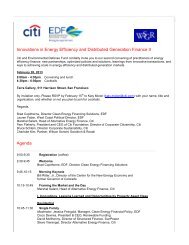Annotated bibliography [PDF] - Environmental Defense Fund
Annotated bibliography [PDF] - Environmental Defense Fund
Annotated bibliography [PDF] - Environmental Defense Fund
You also want an ePaper? Increase the reach of your titles
YUMPU automatically turns print PDFs into web optimized ePapers that Google loves.
prepared for the Cape Cod Commercial Hook Fishermen’s Association (CCCHFA) byArchipelago Marine Research Ltd., Victoria BC Canada. Archipelago Marine ResearchLtd. was contracted by the Cape Cod Commercial Hook Fishermen’s Association(CCCHFA) to evaluate electronic monitoring (EM) as a tool to monitor catch in alongline fishery for haddock where bycatch rates of Atlantic cod must be closelymonitored. This pilot study involved field-testing EM systems on four fishing vesselsfor fishing operations over a three-week trial period. EM systems consisted of twoclosed circuit television cameras, a GPS receiver, a hydraulic pressure sensor, and a datastorage device. The EM systems were in place for 24 fishing trips and 136 fishing events.At-sea observers were deployed on nearly all trips in order to evaluate the quality of EMcatch data. Fishing event imagery was examined for species identification, enumerationof catch and verification of fishing times. EM sensor data provided fine temporal andspatial information about the fishing events. EM catch monitoring (enumeration andspecies identification) was compared with observer data in three ways: overall totals byspecies, species totals by fishing set and comparison of individual catch items (by hook).On the basis of aggregate totals, EM and observers distinguished similar numbers offish species; total piece counts between EM and the observer were within 2%, and 5%for key catch species. The catch comparison by set compared the six most abundantfish species (96% of the catch) and all showed strong correlations (r 2 ) between EM andobserver estimates. The method of comparing EM and observer identifications by hookwas problematic, although there was over 85% agreement between EM and observeridentifications for all but one species. We estimate that catch estimates betweenobserver and EM for haddock and Atlantic cod were within 5%. In this monitoringapplication, EM offers a number of advantages over observer programs including lowercost, labour savings, logistical efficiency, fleet suitability, and increased industryacceptance. Issues hindering the implementation of an EM-based monitoring programinclude expanding fleet awareness of EM program requirements, local infrastructure tosupport such a program, and solidifying data sharing agreements that specify whatinformation would be collected and how it would be used. M programs generally runbetween 20-60% of the cost of an at-sea observer program99. Mid-Atlantic Fishery Management Council (MAFMC), 2006. Fishery Management PlanSummaries for 1) Summer Flounder, Scup, and Black Sea Bass, 2) Dogfish, 3) Surfclam and OceanQuahog, 4) Atlantic Mackererl, Squid, and Butterfish, 5) Bluefish, 6) Tilefish, and 7) Monkfish.Retrieved March 13, 2006, from http://www.mafmc.org/mid-atlantic/fmp/fmp.htm.Current and historical fishery management regulations for specified fisheries.100. Mittal, A. 2004. Individual Fishing Quotas: Economic Effects on Processors and Methods Availableto Protect Communities. U.S. General Accounting Office 04-487. Testimony Before theCommittee on Commerce, Science, and Transportation, U.S. Senate. IFQ programshave achieved many of the desired conservation and management benefits, such ashelping to stabilize fisheries, reducing excessive investment in fishing capacity, andimproving safety. However, concerns have been raised about the economic effects ofIFQ programs on fish processors and fishing communities, among others. The Alaskanhalibut IFQ program has had varied economic effects on processors. The programextended the halibut fishing season to 8 months, allowing more halibut to be processedand sold as a fresh product. This shift to fresh product led to the emergence of the- 17 -


![Annotated bibliography [PDF] - Environmental Defense Fund](https://img.yumpu.com/50613332/17/500x640/annotated-bibliography-pdf-environmental-defense-fund.jpg)

![What do we mean by MSY? [PDF]](https://img.yumpu.com/49525661/1/190x245/what-do-we-mean-by-msy-pdf.jpg?quality=85)

![Print version [PDF] - Environmental Defense Fund](https://img.yumpu.com/46812189/1/190x201/print-version-pdf-environmental-defense-fund.jpg?quality=85)
![Mercury Alert: Cleaning up Coal Plants for Healthier Lives [PDF]](https://img.yumpu.com/45587786/1/190x143/mercury-alert-cleaning-up-coal-plants-for-healthier-lives-pdf.jpg?quality=85)


![Program Overview [PDF] - Environmental Defense Fund](https://img.yumpu.com/34005758/1/190x96/program-overview-pdf-environmental-defense-fund.jpg?quality=85)


